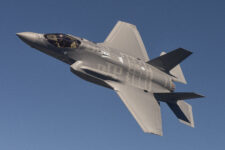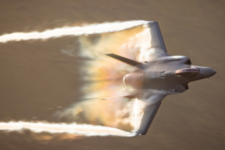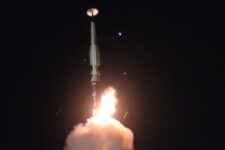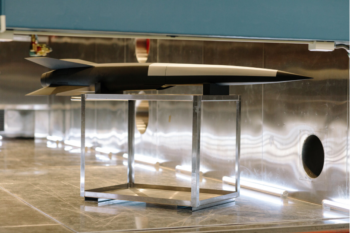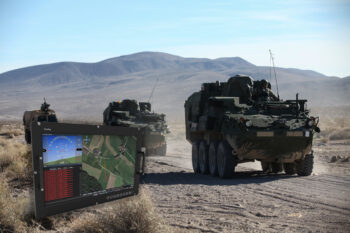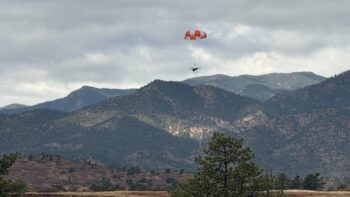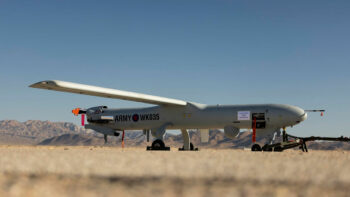
CH-53K King Stallion lifts a Joint Light Tactical Vehicle (JLTV) in tests.
TEL AVIV: Israeli Air Force officials are very concerned by the sensitivity of CH-53K engines to dust and sand and are pressing maker Lockheed Martin for a solution, technical specifications and a timetable for executing the fixes.
The heavy helicopter’s dust problem was revealed soon after its selection by the IAF. Israeli sources told BD that, in spite of the fact the Israelis evaluated the CH-53K for a long time before ordering it, the engine’s sensitivity to dust was not considered a problem.
Now, the US Director of Operational Test and Evaluation’s annual report says the CH-53K engine’s performance degrades bellow the accepted minimum after 21 minutes of dust exposure.
This is causing great concern in the IAF as it eyes buying the first batch of 20 helicopters.
The Israeli Ministry of Defense picked the CH-53K as the replacement for the old CH-53 now in service. The other option was the Boeing CH-47.
Of course, dust and sand are helicopter engines’ worst enemies. When ingested by the engine , they cause compressor erosion, turbine blade glazing, turbine blade vibration and fatigue problems and can block cooling passages.
The critical time is when the helicopter takes off or lands in sandy areas. The rotor wash kicks up a cloud of dust or sand, causing what is known as a brown out.
Officially the IAF will not comment on the problem, but senior experts who talked with BD on condition of anonymity said tha the problem is “very serious” and has to be fixed completely before the CH-53K arrive in Israel.
“The IAF is operating most of the time in dusty environments and has to perform long flights in these conditions. The limitations that were mentioned in the U.S official report cannot be accepted by the IAF,” one source said.
A second expert added that Lockheed’s solution must be “total and massive” before the CH-53K can be introduced into the IAF’s service. The dust and sand mostly damage the engine compressor, but the accumulation of sand inside the engine can also damage turbine components or clog internal air passages for specific engine models. The source added the IAF uses the heavy helicopters very frequently for “long-range combat missions that require many landings in sandy and dusty areas.”
The Israeli defense forces (IDF) Depth Command has asked to have the V-22 tilt rotor for specific missions that require speed and range, but this purchase has been delayed due to budget problems.
Until that is resolved, the CH-53K will perform all missions that need vertical takeoff and landing.
In a statement, Lockheed Martin said: “Sikorsky and our customer continue to operate an integrated test plan and are committed to enter Initial Operational Test & Evaluation as planned in June, support operational deployment and expand production of this all-new heavy lift helicopter.
“The team is already addressing technical issues cited in the report, a majority of which have been resolved, and are confident we have solutions to address the few outstanding issues to enter into IOT&E as scheduled this year.
“We understand the sand ingestion issue and, as the aircraft integrator, have assigned a dedicated team of our most experienced engineers to work alongside NAVAIR and GE to resolve this issue.”
Marine Corps Col. Jack Perrin, program manager for the CH-53K said this on Feb. 24:
“We went out to Yuma, Arizona in the July-August-September time frame of last year. You saw some of those pictures of the 53 coming into that sand, dusty area I’m sure you’ve seen those videos on YouTube,” Perrin said. “It was stunning to see the brown-out conditions that was developed in order to make it very, very challenging. The CH-53K was able to come in, hover, remain very stable and land. The test included carrying and delivering an external load. “It worked extremely well. The workload was way reduced and that’s really driven because of those flight controls and that fly-by-wire system on the aircraft. This is one of the most stable platforms out there. It really, really does well.”
Here’s betting the Israelis do their own tests and draw their own conclusions.
Romania signs LOA to secure entry to F-35 club
“This decision marks a significant milestone in Romania’s defense strategy and its commitment to maintaining a robust and advanced military force,” Lockheed Martin said in a statement.
